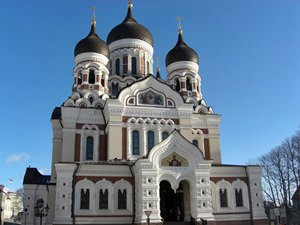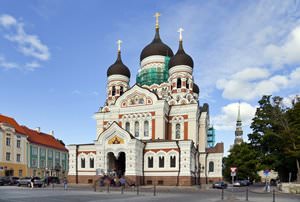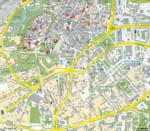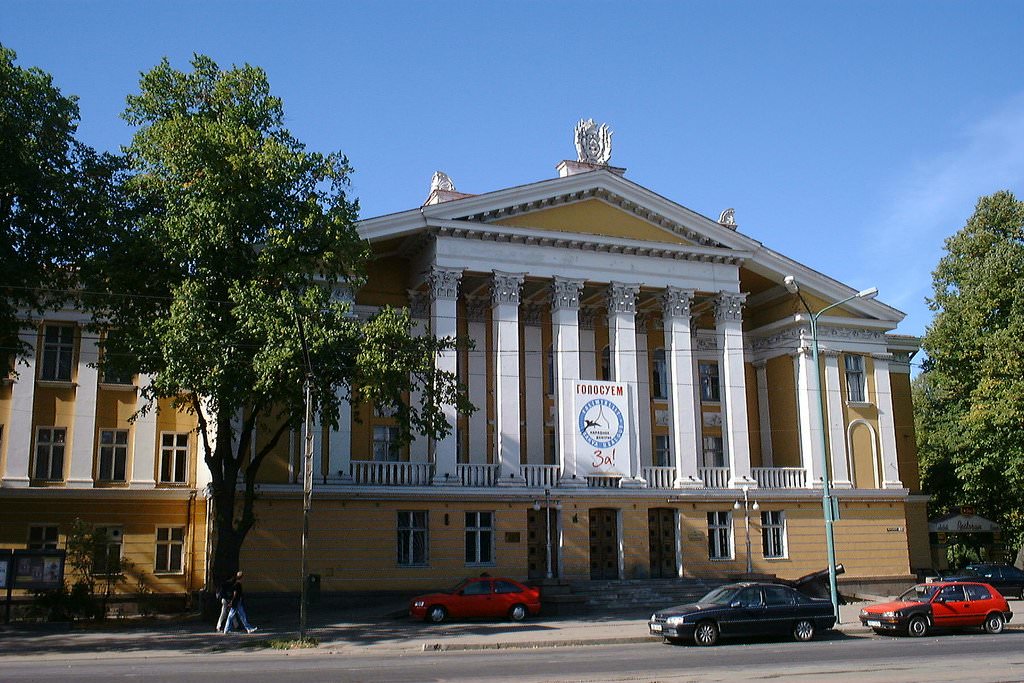Top architectural sightseeing and landmarks of Tallinn - ideas on city exploration routes
 The cultural capital of Estonia - Tallinn – never ceases to attract travelers by dozens of iconic architectural and cultural landmarks. Alexander Nevsky Cathedral, St. Nicholas Church, St Mary Cathedral, and Kiek in de Kok is, by far, not the complete collection of objects of interest. In this review, we will try to include descriptions of the most important architectural landmarks of Tallinn. We accompany them with interesting facts, colorful photographs, and 3D virtual tours. These 3D tours allow you observing the landmarks from a bird’s eye view. Simply turn on the HD video and enjoy the flight!
The cultural capital of Estonia - Tallinn – never ceases to attract travelers by dozens of iconic architectural and cultural landmarks. Alexander Nevsky Cathedral, St. Nicholas Church, St Mary Cathedral, and Kiek in de Kok is, by far, not the complete collection of objects of interest. In this review, we will try to include descriptions of the most important architectural landmarks of Tallinn. We accompany them with interesting facts, colorful photographs, and 3D virtual tours. These 3D tours allow you observing the landmarks from a bird’s eye view. Simply turn on the HD video and enjoy the flight!
Alexander Nevsky Cathedral, Tallinn
Location on the map:  Facts:
Facts:
» The five-domed cathedral is located on a small hill and is seen from afar. The Alexander Nevsky Cathedral was built and blessed by the bishop in 1990. The wonder-working icon of the Mother of God was delivered for the ceremony. » The allocations of the Synod were not sufficient for the construction. The missing amount was collected in Rus. The sacred house is a reminder of saving royal figures after the train accident.
» The ethereal defender of Emperor Alexander III was Prince Nevsky. The cathedral was named after him.
» There are gilded iron crosses above the domes. There are mosaic panels on the facade. There is stained glass in the windows. 11 temple bells weigh over 26 tons. They were made in St. Petersburg. Ringers toll before the church service. The ringing bells are heard throughout the district.
» The interior is decorated according to the Biblical sketches of architect Preobrazhensky. There are many mosaics and icons inside. The wooden gilded iconostasis occupies the central wall of the cathedral.
» In the 30s, the government decided to demolish the cathedral but the abbot, the brother of the Estonian President, defended it.
» The cathedral was built in the likeness of temples of the 17th century and accommodates 1.5 thousand people.
St. Nicholas Church, Tallinn
Location on the map:  Facts:
Facts:
» The temple was named after the patron of sailors, St. Nicholas. German merchants found it in the 8th century. The room was used for commercial transactions. » The house was being built for hundreds of years. In the 14th century, a western tower was built. The walls of the church had defended the building from enemies’ attacks for a while.
» During the Second World War, the building was partially destroyed due to the air raid. Some medieval pieces of art were saved.
» After the war, the building was being reconstructed. The spire was restored. Years later, it collapsed in coincidences.
» Former Lutheran St. Nicholas Church started to serve as a museum. It houses artifacts from several churches.
» The part of the preserved painting “The Dance of Death” is especially valuable. It is displayed in St. Anthony Chapel.
» The building has amazing acoustics, so organ concerts and church choirs are often held here. You can learn more about the way of life in ancient Tallinn by visiting exhibitions held in the Niguliste Museum.
» You can see a range of gravestones in the territory of the church. One of them dates back to 1520.
» The building of the church was even shown in several films. The church is not used for masses.
St Mary Cathedral, Tallinn
Location on the map:  Facts:
Facts:
» At the beginning of the 13th century, a small wooden church named after the Most Holy Mother of God was built in Old Tallinn. » The exterior of the building has changed for hundreds of years. The burials of famous people with verses in their honor have been preserved.
» The building combines different architectural styles. Only the wooden part of the altar has remained untouched. There is the painting of crucified Jesus above it.
» The spruce ceiling above the honorable bishop’s seat in the long hall enhances the sound of the preacher’s voice. There are carved graphic compositions (wooden arms) of famous families on the walls.
» In the organ gallery, there is a 47-tone mechanism made by the German master in 1878. It sounds incredible due to the good acoustics in the gallery.
» When Catherine II ruled, the bell tower was built above the cathedral. You can climb up the stairs to reach it.
» The octagonal carcass ends with the gallery in the form of the arch. There is a vane attached to the sphere above it. It is crowned with a gilded flower that resembles a lily, the symbol of the Virgin Mary’s virginity.
» The white stone Dome Cathedral is the residence of the bishop of the Evangelic Lutheran Church.
Kiek in de Kok, Tallinn
Location on the map:  Facts:
Facts:
» As the legend says, medieval guards looked at kitchens of residents through chimneys from the 38-meter artillery tower. That is why it is called Kiek in de Kok. » The stronghold had been built for 8 years. It was finished in 1470. Its walls are 4 m long, its height is 48 m, and its diameter is 17 m.
» The upper level was destroyed by the troops of Ivan the Terrible but the tower survived. Round shells that weigh 100 kg were put into the walls.
» Powder was kept at the ground level. There are furnaces for heating balls.
» The tower ends with a platform. Soldiers fired balls and poured melted metal onto enemies from it.
» You can learn more about the military history of the city by visiting the museum in the tower. Each of the six levels of the fortification is dedicated to a particular period.
» At the first level, you can acquaint with modern art. You can also see old weapons and medieval household items here. There are models of fortress walls at the third level. Historic films can also be of your interest. At the 4th level, you can see military items of different periods and exhibits performing the period of the plague and ancient tortures. The 5th level is an arms hall with lots of interactive stands. There is a cafe at the last level.
» You can see the city through vaulted windows.
Kadriorg Palace, Tallinn
Location on the map:  Facts:
Facts:
» The park complex on the hill slope has a total area of 70 hectares. It was found several centuries ago (at the beginning of the 18th century) as the summer cottage of Peter the Great, as a gift to his wife. As the legend says, Peter I placed the first stone into the foundation of the building himself. » Now, there is a museum at the 2nd level of Peter’s House. His personal belongings are kept here.
» The park has preserved its landscapes since that time: small ponds with fountains, a flower garden, Swan Pond with black swans, an island, and a gazebo.
» The name “Kadriorg” came from Kadri, which is the Estonian name for Catherine.
» Exhibits from the Estonian Art Museum made by the Italian architect are kept in the palace. The palace accommodates almost 200 people.
» The part of the facade protrudes and takes the whole height of the building. In the wall of the lobby, there is a memorial plaque with the picture of the Russian state symbols and the anchor, as well as with the Latin text about the start of construction.
» The interior of palace rooms (the White Hall) is decorated with moldings and azure columns. There are plafonds with flower decorations on the ceiling.
» The entire territory is decorated with sculptures and monuments to culture figures, the rosary, and the Japanese Garden.
Church of St. Charles, Tallinn
Facts: » The Church of St. Charles (Kaarli) was found many centuries ago, in 1670. It was named after the Swedish King, Charles XI.
» It was restored on donations from parishioners in the early 19th century. The city population grew at that time, so there was a necessity in constructing the new House of God.
» It has two towers with spires. The building is made of monolithic limestone slabs and impresses with its size. The church resembles the Latin cross with its shape. According to the project, sculptures should have been installed in the niches but there are no sculptures now.
» There are arched windows on the exterior facade. There is a German-made clock (1990) in the round window above the door. One church bell has been preserved since the construction of the building.
» The wooden ceiling is upheld by brick arches. So, there are no partition pillars, so the room seems to be spacious.
» There is an organ with 81 tones which lets play classical and sacred music for 1500 listeners.
» The first Estonian fresco of 1870 has a historical value. At the bottom of the altar, there is a painted composition of blessing Christ consisted of 3 parts.
This guide to architectural sightseeing in Tallinn is protected by the copyright law. You can re-publish this content with mandatory attribution: direct and active hyperlink to www.orangesmile.com.
City tours, excursions and tickets in Tallinn and surroundings
Build your walking routes in Tallinn on the landmark map
Expo 2020 in Dubai Was Visited by More Than 7 Million Visitors
If you haven’t visited this event yet, there is still time to book a hotel in Dubai because Expo 2020 Dubai runs until 31 March 2022. People who are unable to visit the emirate can make a virtual tour on the Expo 2020 website. By the way, the virtual visitation has already reached 31.6 million by the end of December. Read this
Read this
27.07.2024
If you haven’t visited this event yet, there is still time to book a hotel in Dubai because Expo 2020 Dubai runs until 31 March 2022. People who are unable to visit the emirate can make a virtual tour on the Expo 2020 website. By the way, the virtual visitation has already reached 31.6 million by the end of December.
27.07.2024


 English
English Russian
Russian Dutch
Dutch German
German Spanish
Spanish French
French Türkçe
Türkçe



















